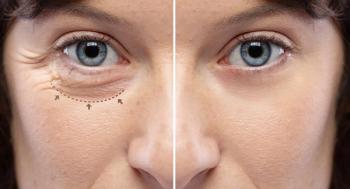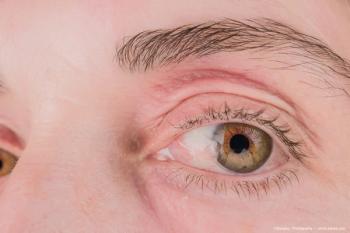
- Ophthalmology Times: October 1, 2021
- Volume 46
- Issue 16
Advances in cataract surgery show value in tools, tech for surgeons
Three cases demonstrate value of new tools, technology for surgeons.
Special to
Ophthalmology Times®
Although modern
Here, I will discuss 3 recent cases that illustrate the value of new technology in cataract surgery.1
Case 1: Cataract patient with severe untreated glaucoma
The patient was a 73-year-old, non–English-speaking woman referred by a local retina specialist. She had non–insulin-dependent diabetes, as well as high cholesterol and hypertension.
Her ocular history was significant for diabetic retinopathy and macular cysts in both eyes. She was not on any topical eye drops.
Upon examination, I found that her best-corrected visual acuity (BCVA) was 20/50 OD and 20/40 OS. She had 3+ nuclear sclerosis and 1+ cortical cataracts in both eyes.
Related:
The IOP was not high (17 to 18 mm Hg), but she had severe visual field constriction in both eyes, as well as loss of retinal nerve fiber layer and retinal ganglion cells, worse in the left eye than the right.
The cup to disc ratios were 0.76 oculus dextrus (OD) and 0.72 oculus sinister (OS).
Pachymetry was slightly thinner than average OU; the angles were narrow but open. I diagnosed the patient with normal-tension
To address the already-severe glaucoma, we needed to get her pressure significantly lower.
Given that, along with the patient’s language barrier and financial challenges expressed by her family interpreter, I determined that drops alone might not be successful.
Fortunately, we have several options to perform minimally invasive glaucoma surgery (MIGS). I particularly like the combination of the microstent (Hydrus Microstent; Ivantis, Inc) and viscocanalostomy with a surgical system (Omni Surgical System; Sight Sciences).
Not only do the 2 together significantly reduce IOP by improving outflow, but performing a 180° canaloplasty gives me the flexibility to come back later and treat the remaining 180°, with or without goniotomy, if I need greater pressure reduction in the future.
Related:
Additionally, performing the Omni procedure first opens the channel and makes insertion of the microstent (Figure 1) quick and simple.
The MIGS procedure added only a few minutes to the case, and this patient ended up with an excellent result: 20/20 visual acuity OU and a reduction of her IOP into the 12 to 13 mm Hg range without drops.
I do not have a nearby glaucoma specialist to refer patients to and would prefer to avoid trabeculectomy for my patients, so being able to use these new technologies to titrate MIGS to disease severity at the time of
Case 2: Cataract and ocular surface disease
A 68-year-old retired, female patient presented for a cataract evaluation, complaining of decreased vision over the past year (worse in the left eye) and difficulty driving at night due to glare.
She had previously received a diagnosis of dry eye, MGD and mild age-related macular degeneration. Systemic conditions included arthritis and seasonal allergies.
Upon examination, her BCVA was 20/25 OU, decreasing to 20/50 with glare. She had visually significant regular astigmatism and desired spectacle independence.
The
Related:
Her IOP was in the 18 to 20 mm Hg range, with a cup to disc ratio of 0.5 OD and 0.45 OS. There was no history of glaucoma.
I decided to implant toric
In my experience, this intracameral steroid very effectively controls inflammation with little impact on IOP and is an excellent choice for most patients undergoing cataract surgery.
The ability to reduce or eliminate postoperative drops greatly improves the surgical experience for patients—of particular importance for those receiving premium IOLs and for anyone with
Because this patient had OSD, I wanted to be as kind as possible to the ocular surface and minimize any discomfort after surgery. She was 20/20 uncorrected, and the toric lens was in perfect position after surgery.
On postoperative day 1, the patient had 1-2+ anterior chamber cells, with almost no cells by the 1-week visit and none at the 1-month visit.
Related:
Although dexamethasone 9% is a great option for most cataract patients, I recommend initially using it for patients with social, physical, or cognitive limitations that prevent them from administering drops reliably or for patients with severe OSD.
Once you are comfortable with the injection technique, you can expand your use of dexamethasone 9% more broadly.
Additionally, rather than injecting the spherule behind the iris, as we were initially taught, I prefer to inject it (Figure 2A) into the capsular bag, where the capsulorhexis overlap of the lens optic and the inferior edge of the lens haptic can hold the spherule in position (Figure 2B).
With this approach, the medication stays
in place nicely rather than popping out, especially in a patient with larger pupils.
Case 3: Presbyopia-correcting IOL candidate
A 56-year-old pastor presented for a cataract evaluation with complaints of decreased vision interfering with daily activities and night driving.
He wore contact lenses to correct for moderate myopia and had previously received a diagnosis of MGD.
Related:
Upon exam, BCVA in the left eye was 20/40, worsening to 20/80 with glare. The macula, optic nerve, and IOP were all normal.
He had 1+ nuclear sclerosis, with a 2+ posterior subcapsular cataract (PSC) OS and 1+ PSC OD.
He wanted spectacle independence, with a strong need for good intermediate vision for computer work and the ability to see his notes on the lectern in church. I planned femtosecond laser-assisted cataract surgery on the left eye with a PanOptix (Alcon) trifocal lens.
We discussed that he would wear a multifocal contact lens OD until that eye could be treated and that he would need to stop wearing contact lenses for 2 to 4 weeks prior to biometry.
With a patient who has
Related:
In the past, this would have involved having multiple screens open on my computer and flipping back and forth between screens and printouts.
Since I started using the Veracity Surgical preoperative planning software (Carl Zeiss Meditec), I have been able to quickly see all the patient’s preoperative data from multiple diagnostic devices in our office and compare refractions and keratometry across different devices (Figure 3).
I can run multiple IOL power calculation formulas (including toric and postrefractive formulas, when needed) to ensure the correct IOL choice.
Veracity is so much more efficient than the “old” way of doing things. I can tell right away, while the patient is still in the lane, if I will need to bring them back for more biometry after a period of intensive ocular-surface management.
The system also pulls information from our electronic health record system and alerts me to any medical or ocular issues (Figure 4) that might affect the outcome, providing an extra measure of safety.
This patient’s Ks were in good agreement at the start. He ended up with a nearly 20/20 uncorrected visual acuity outcome and is looking forward to surgery with the same IOL in the fellow eye.
These just a few of the cutting-edge advancements in the field of cataract surgery.
About the author
Lisa K. Feulner, MD, PhD
E:
Feulner is the founder of Advanced Eye Care & Aesthetics in Bel Air, Maryland. She is a paid consultant for EyePoint Pharmaceuticals, Inc.
Articles in this issue
about 4 years ago
ARMOR study: Keeping pace with microbial resistance to antibioticsabout 4 years ago
Surgeons are changing delivery methodabout 4 years ago
Home monitoring of wet AMD offers high-quality scansabout 4 years ago
Study examines VR orientation, mobility testingabout 4 years ago
Bilateral retinoblastoma tumors: The same but differentabout 4 years ago
Should we always trust the OCT?about 4 years ago
The relationship between myopia and conjunctival-scleral geometryover 4 years ago
Depth-of-focus enhancement makes target easier to hitNewsletter
Don’t miss out—get Ophthalmology Times updates on the latest clinical advancements and expert interviews, straight to your inbox.








































